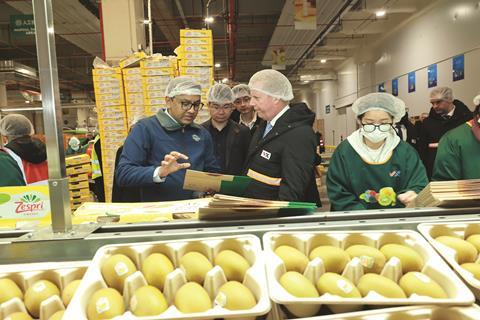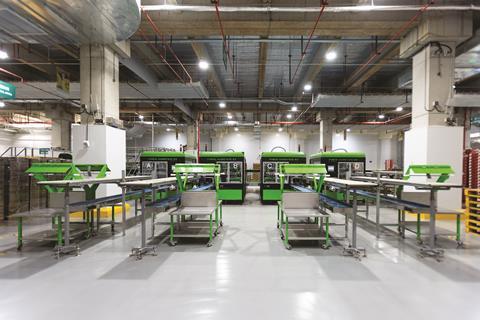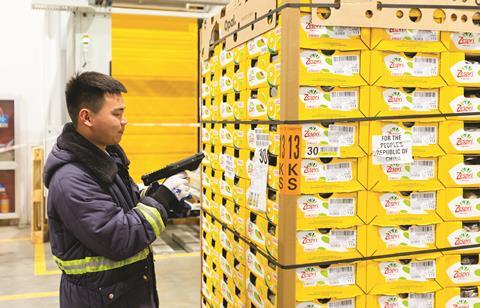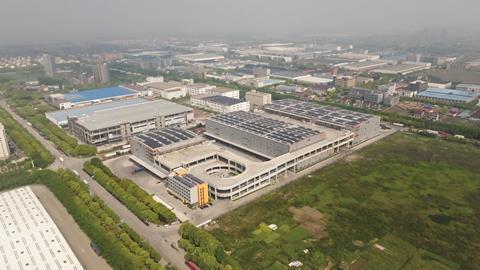As the kiwifruit company prepares for Asia Fruit Logistica, its head of supply chain for Greater China, Rahul Bagde, explains how it is transforming its distribution network
Kiwifruit marketer Zespri has embarked on an ambitious project to build out its supply chain operations in China over the past six years. It’s a journey anchored by its partnership with integrated logistics service provider VX Cold Chain to create the state-of-the-art Fresh Hub facility in Shanghai’s Lingang Free Trade Zone, which opened in April 2023.
Rahul Bagde joined Zespri back in 2018 to head up supply chain for the Greater China region, incorporating mainland China, Hong Kong and Taiwan. Bagde had a background working in supply chain for major blue-chip organisations such as Microsoft, Siemens, Phillips and San Disk, so the fresh produce industry presented a learning curve. But it’s a journey he says he has relished, drawing on his expertise from outside the industry to help modernise and digitise Zespri’s supply chain operations.
“First of all, it’s been a good learning opportunity, because I knew nothing about the food industry before joining,” reflects Bagde. “Second, it has been wonderful to be part of a team focused on establishing our own infrastructure in China and designing the future supply chain for Zespri.”
Zespri only became an importer of record in China in 2016, and it began to keep some inventory in the market from 2017, just before Bagde joined.
“We didn’t have any infrastructure on the ground, so we were leveraging pretty much 100 per cent our distributors’ facilities,” he says. “Our goal was to create a foothold in the China market with our own operations, our own infrastructure, and to digitalise a significant part of our operations. We were on course to double our volumes within five years, so we needed to do this.”

Supply chain targets
Bagde says Zespri set out with four key goals for its supply chain. The first was to achieve “end-to-end quality management”, he explains.
“It was about how we integrate between Zespri, our distributors, their tier-one customers and the wholesale markets, to ensure we have an end-to-end view of the quality.”
The second part focused on creating ripening infrastructure in-market. “We learned from our operations in Japan that there is a lot of value if you serve the market with ready-to-eat, ready-to-retail product,” notes Bagde.
Zespri’s third major focus was on being able to supply consumer packaging. “Emotional occasions in China are key to selling products. You look at different festivals and customise packaging to sell to the consumer,” he explains.
The fourth part was around the quality of infrastructure. “In this industry, there’s generally less appreciation of the value the right infrastructure brings to products,” Bagde says. “People look at storage more in terms of just keeping the product, but we need to change that mindset in the industry.”
‘World-class infrastructure’
When Michael Jiang took over as GM of Greater China in 2019, Zespri formed a strategic group with its two distributors (Joy Wing Mau and Goodfarmer) and key functional people to lead this strategy. “There are enough storage providers, but we needed to transition to the world-class infrastructure we see in New Zealand,” says Bagde.
Zespri partnered with VX Cold Chain to co-design that infrastructure. On what was bare land in 2021, VX built the Fresh Hub facility – VX Shanghai Lingang Park. It committed to VX with its five-year plans and assurance of supplying sizeable volumes of fruit for handling and throughput. VX in turn invested around Rmb400 (US$55m) to build the world-class infrastructure Zespri required.
“This facility marks the first time a product owner and service provider co-designed a facility based on the future demand of the product owner and the capabilities we required,” says Bagde.
This, he says, was one of many “firsts” with the VX Fresh Hub facility. “It’s the first facility that has an automated storage and retrieval system. That gives you better storage and labour efficiency in terms of how pallets are stored because it’s all automated.”
The VX Fresh Hub is also home to China’s first fully automated kiwifruit processing line, which was designed specifically for Zespri by MAF Roda, according to Bagde.
“The processing line enables us to create the scale to process consumer packs for retail and create the transition from bulk to layers,” he explains. “It means customisation can happen closer to demand in the market – say if we want to change our packaging specifically for the Mid-Autumn festival in September.”
The other key ‘first’ was around the ripening infrastructure on site, which enables Zespri to service the ready-to-eat and ready-to-retail market. “We needed to create a ripening infrastructure which was more decentralised,” he says. “That includes ripening infrastructure within the Zespri facility, as well as with our distributors.
“Firstly, this ensures the eating experience of ripened fruit is much better for our consumers,” he says. “Secondly, it boosts our sales rates from early in the season because when consumers buy the product, they’re not waiting for a week for it to ripen before they eat it.”
Another distinctive feature of the facility is its intelligent energy consumption, which results in practically zero carbon emissions. “The daytime power for the facility is supplied by almost 16,000m2 of solar panels on the roof,” says Bagde. “It has a LEED Platinum certification from the US Green Building Council.”

Efficiency gains
Bagde says the VX Fresh Hub has already helped to drive dramatic improvements in the efficiency of Zespri’s operations in China. “It used to take us four or five days from receival of a charter vessel to process and deliver fruit to customers, but it’s now taking us just two-and-a-half days,” he says.
He highlights the digitalisation of many of its operational processes as another key benefit. “When I am sitting in India, I can see on my phone what’s happening in the warehouse pretty much live. I can direct people on the ground remotely without having to be present,” he says. “My experience with Microsoft was the inspiration for this digital journey in Zespri Greater China.”
One of the keys to efficiency gains is the sheer capacity of the VX facility, which can comfortably accommodate the discharge of specialised charter shipments. “It’s a three-storey facility with four chambers with a combined capacity 18,500 pallets, and you can actually discharge fruit at all three levels,” says Bagde. “When we bring in charters, we pretty much handle 6,000-7,000 pallets, so you need to have the scale.”
Charter change
Up until 2022, Shanghai Lingang Port was the only charter port available to Zespri. When Shanghai was locked down during the Covid-19 pandemic, Zespri moved swiftly to develop an alternative port to receive charter shipments.
In a matter of just 45 days, it set up a hub at Yuhuan Port in Taizhou, more than 400km south of Shanghai, building a cold store there.
Yuhuan now functions as a back-up charter port to Shanghai Lingang, but the Shanghai lockdown also prompted Zespri to diversify its options to reduce its reliance on the one single port for charters.
Last year, it developed a third charter port in Shatian in Dongguan, Guangdong province. Now, around 70 per cent of Zespri’s arrivals into China come in via Shanghai and Yuhuan. A further 15 per cent enter the southern ports of Shatian (charter) and Yantian (container) in Guangdong province. The remaining 10-15 per cent of arrivals go into Tianjin (serving Beijing), and Dalian in the north.
Moving forward, Zespri plans to replicate the infrastructure it has established with VX in Shanghai in other ports. “VX has already opened a similar fresh hub in Dongguan where the southern charter shipments come in this season,” says Bagde. The next focus is Tianjin, where Zespri is in talks with VX to determine what aspects of the Shanghai operation can be replicated in the northern port.
The development of the onshore infrastructure has enabled Zespri to switch the bulk of its shipments to charter vessels rather than container lines. “Prior to Covid in 2019, we were shipping roughly 30 per cent of our volume for China in charters and 70 per cent in containers,” says Bagde. “Over the past four years, we’ve switched the ratio to almost 70 per cent coming in charters and 30 per cent in containers.
“Containers still play an important role because charters are inflexible – you can’t cancel them with a short lead time. The containers allow us to adjust the flow of supply.”

End-to-end goal
While VX’s landmark investment has created a platform to meet Zespri’s future supply chain needs, Bagde points out that the journey to achieve end-to-end quality management is far from over.
“Most businesses I’ve seen kind of lose control of their product as soon as it leaves their facility,” he says. “How do you track the quality of your fruit through different supply chains, be it e-commerce channels, traditional wholesale, and ultimately all the way to the consumer? So that when the consumer complains about the quality of the fruit, you have the capability to analyse what’s going on and fix it.
“That’s our ambition and focus over the next few years – we’ve made some headway, but I’d say we’re only 30 per cent of the way there in terms of achieving true end-to-end quality management.”




